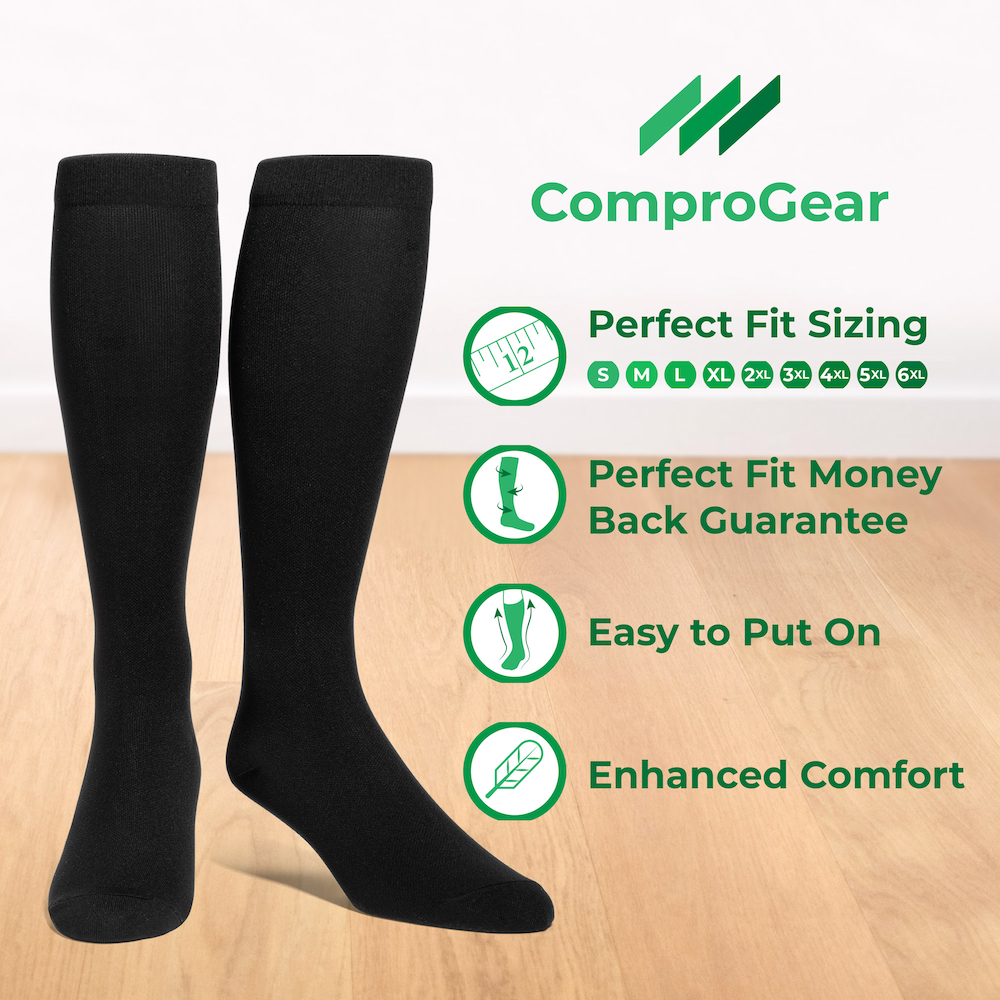Knee-high compression socks are designed to lessen the risk of painful swelling in the feet and lower legs. They are also used to reduce the risk of developing deep vein thrombosis (DVT), a type of blood clot that usually develops in the lower legs.
To learn more about compression socks, why you should use them, how they work, and the benefits they provide, read on below.
Why Do I Need Compression Socks?
There are many reasons you might want to consider using compression socks.
First of all, DVT and swollen feet can develop during travel over long distances, so if you plan to travel for several hours, using compression socks can help. DVT can be quite painful, and if it is left untreated, it can cause significant problems with your blood circulation and may require urgent medical attention, including surgery.
In extreme cases, a DVT can travel through the body and cause a pulmonary embolism, which happens when a DVT blood clot makes it way to the lungs, and this can cause death if medical treatment is not immediately delivered.
Compression socks, however, can help improve the flow of blood in the legs, thereby reducing the risk of DVT, not to mention edema which results from fluid retention in the legs.
In short, compression socks are of particular benefit for passengers traveling on a plane for a very long time, or for anyone who tends to remain relatively stationary for hours on end, such as office workers who work at a desk or support staff who spend much of their time on the phone.
What are Compression Socks and How Do They Work?
Compression socks are designed to improve circulation and blood flow in the legs. They come in a wide range of materials, complete with supportive designs and varying compression levels depending on the specific needs of the individual. They are designed to help you enjoy better blood circulation, reduce the risks of edema and DVT, control foot odor, and provide support to the arch of your foot for better posture.
Improved blood circulation via compression can help revitalize the muscles in the legs.
It also helps you recover from leg pain and the wear and tear that the feet and legs experience as a result of, for example, exercise, or even surgery.
As mentioned earlier, compression socks can help reduce leg swelling, and it can help you feel livelier and more refreshed, even after a long shift or a long stint on the job. With compression socks, you never need to worry about pain or discomfort that results from a long-term sitting or extensive walking and running.
In simple terms, compression socks are designed to improve blood circulation, provide support to the legs, and limit the physical stress that the feet and legs must endure as a result of daily errands and regular work that you do on a daily basis.
Compression socks are worn by people from all walks of life, from athletes and runners to CrossFit competitors, office workers, warehouse employees, delivery personnel who spend a lot of time on their feet and on the move, as well as the elderly. They are recommended for everyday use by women who are pregnant, nurses, and professionals who are required to spend extended periods of time either standing or sitting.
Compression socks are also used by patients who are recovering from leg conditions of various sorts because they can help improve blood circulation and enhance leg comfort, thereby helping the patient recover more quickly. Before purchasing compression socks, consult with a physician or a specialist for medical advice. Do not forget to inform your doctor about any health issues that you have or any medical conditions you had in the past.
Benefits of Wearing Knee-High Compression Socks for Medical Purposes
For those dealing with a medical condition, compression socks can help improve circulation. This will help treat your leg muscle fibers and potentially reduce the time for recovery, provided they are used with a prescribed medical health regimen and in line with professional medical advice.
Compression socks can prevent the progression of venous disorders in patients who suffer from poor blood flow, varicose veins, and other venous maladies.
Unlike regular socks, premium compression socks use tight elastic materials that have unique properties. They apply consistent pressure on the feet, legs, and ankles to enhance blood flow and oxygenation of the tissues and muscles in the legs. If you experience swelling in the legs or ankles, have varicose veins, or suffer from fluid buildup in your feet or legs, try using compression socks.
If you have heart issues, are diabetic, are dealing with a leg or skin infection, or have a chronic arterial disease, consult with your physician before you use compression socks in order to avoid further complications with your health.
In summary, the medical benefits of wearing compression socks are:
- They help prevent or at least minimize the incidence of varicose veins
- They reduce swelling in the legs
- They help to improve oxygenation and blood flow in the legs, ankles, and feet
- They facilitate the quick recovery of sore or aching muscles
- They help deal with lymphedema
- They can reduce the occurrence of venous ulcers
What are Thigh-High and Knee-High Compression Socks Used For?
Compression socks can be used by anyone who wants to improve their blood circulation, add a layer of comfort and support to the feet, and reduce swelling in the legs. Folks who are dealing with a specific medical condition should first consult their doctor before using compression socks. However, in general, compression socks can be used by anyone and provide numerous benefits as outlined above when they are used correctly.
It is important that you choose the correct pressure level before buying yourself a pair of compression socks. You can check the required compression level by looking at the compression strength of the socks marked on the socks’ packaging.
Compression levels are usually listed as follows:
- 8-15mmHg (mild compression)
- 8-15mmHg (moderate compression)
- 15-20mmHg (moderate compression)
- 20-30mmHg (rigid compression)
- 30-40mmHg (extra rigid compression)
The higher the compression, the tighter the socks will be, and higher levels of compression can have a profound impact on the firmness of the sock and on your blood flow.
Therefore, choose your compression level based on your overall health and your specific needs for pressure on the legs and feet.
Compression Stockings For Daily Use
Compression socks are known for their benefits in the athletic and medical fields, but they are frequently used by workers who need to improve their foot support and their blood circulation in the legs. Such individuals include office workers, restaurant and hotel staff, health care workers, and many other working professionals.
Maternity compression socks, also known as pregnancy compression socks, are often applied by women who want to limit their risk of thrombosis, varicose veins, or phlebitis, and to reduce the pain and swelling that occurs in the ankles and feet, especially during pregnancy.
Compression Stockings and Clothing For Athletes
Apart from individuals who use compression socks to recover from various medical conditions, compression clothing can be worn by anyone, including athletes, soccer players, football players, runners, and those who participate in sports of other types as well.
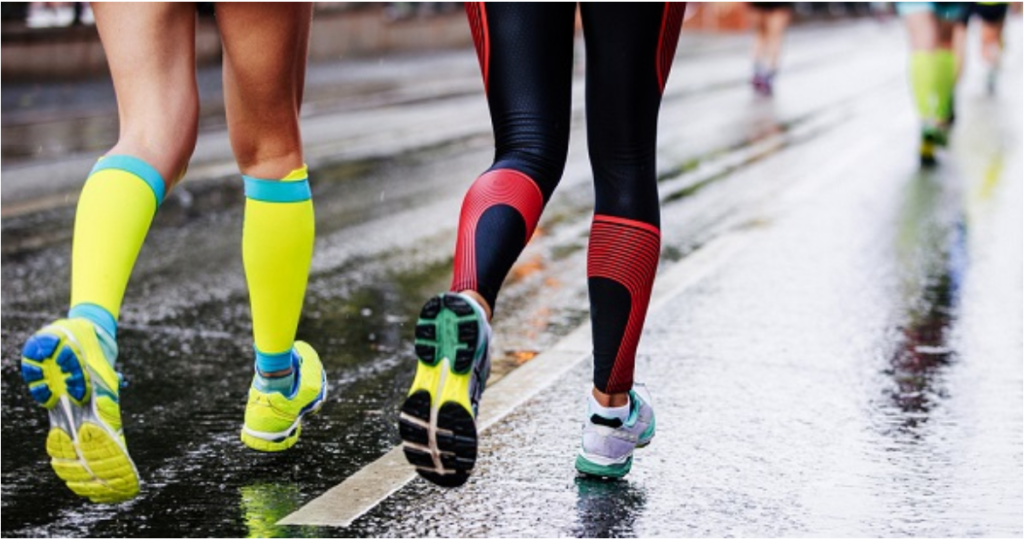
These individuals wear compression socks so that they have better blood flow and support for the feet, ankles, and heels. Since compression socks are made using a variety of materials and come in numerous designs, they can be customized for use in a wide range of athletic activities, and you can even find compression socks tailored for use in individual sports, depending on the needs of the user.
Popular Articles on ComproGear
Medical Compression Socks Graduated Medical Compression Stockings
When Shouldn’t You Wear Knee-High Compression Stockings?
Anyone suffering from cardiovascular issues, skin rashes, or reduced blood flow should not wear compression socks since constant pressure on the legs can worsen such conditions.
Avoid using any type of compression garment, including compression sleeves, stockings, and socks. Speak with your physician for advice on the kind of compression clothing you can or should wear so that you don’t place unnecessary pressure on your body and alter the flow of blood to your own detriment.
Other Benefits of Compression Stockings
Compression socks offer a vast array of benefits for first-time and regular flyers, including:
- Promote Circulation: Pilots and flight attendants wear compression socks. Compression socks can help an individual’s blood flow from the feet back to the heart, thereby promoting good circulation. Even if you are in a plane sitting or walking for a long time, you will not feel uncomfortable.
- Reduce Discomfort and Pain: Compression socks can help keep your legs from fatigue and aches. Various studies have found that compression socks can help prevent the development of varicose and spider veins.
- Reduce Sweat and Odor: An amazing effect of wearing compression socks during a long flight is that they are usually moisture-wicking and come with odor-reducing antimicrobial properties.
- Add Additional Comfort: Compression socks are not primarily designed for flyers. They have several practical applications outside the airplane. You can wear them to manage pain and discomfort when hiking, going sightseeing, strolling, or even while running, jogging, or exercising.
Thigh-High Compression Stockings or Knee-High?
When selecting compression socks, one vital question to ask is, should a patient go for knee-length or thigh-length? The answer is, indeed, surprising. Why? A few folks believe that thigh-high and knee-high compression stockings have different effects and benefits. However, before answering this question, it is beneficial to review some research regarding these two types of compression socks.
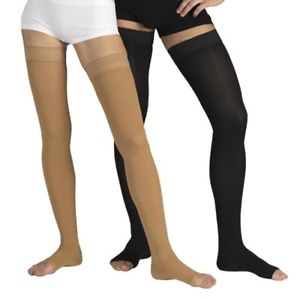
In a study published nine years ago by a clinical nurse specialist, knee-high compression socks were favored because they proved to be more comfortable for nurses and patients. Furthermore, they tend to be less expensive than thigh-high socks, and they are easier to wear as well, not to mention fewer cases of rashes and sores around the elastic band of the sock.
Another study carried out by St. Cloud hospital in Minnesota provided a different viewpoint. This study was conducted to determine the best choice of compression socks between thigh-high and knee-high. The results of this study were not similar to those obtained by the clinical nurse specialist study, and it found that knee-high compression socks do not provide comfort to some patients since their knees are not covered, and it also found that thigh-high compression feels tight knee-high designs can sometimes slide down the leg.
In another study, conducted by Harvard University and involving 267 patients suffering from DVT across seven general hospitals in Italy between October 2005 and September 2007, patients were randomly assigned thigh-high or knee-high compression socks to wear for two years every day. After three years, a follow-up was conducted. The study revealed that some patients who were given knee-high compression socks developed post-thrombotic syndrome, while those with thigh-high wears developed other side effects that included itching, redness, and thus, indicated weak compliance to patient comfort.
With these studies in mind, what can be concluded? It must be noted that these studies have limitations and might not apply to all wearers of compression socks. Everyone is unique in terms of preferences and the level of comfort and convenience that they look for in compression socks.
Note: I am not recommending knee-high compression stockings over thigh-high designs. Also, I am not saying that they are more effective or comfortable. However, knee-high and thigh-high compression stockings both have similar functions and effects which are designed to enhance blood circulation and the prevention of blood clotting.
What really matters is your doctor’s prescription. For instance, if you need to choose between thigh-high or knee-high, your doctor will carefully examine your condition and then he or she might prescribe one or the other, depending on whichever will work best based on your specific situation.
Therefore, answering the above question is tricky, but what you need to do is conduct detailed research. There are many articles that will guide you and your doctor will give you the ultimate answer. In any case, you have the final say but always consult with your physician first.
What You Should Know When You Want to Buy the Best Compression Socks
There are a few things that need to be noted before you purchase a pair of compression socks.
Compression socks act like an extra layer of muscle in the body. They apply pressure to specific areas to help blood return to the heart. This has a positive impact on the body and lowers the production of lactic acid and leads to an increase of oxygen in the blood. The indication of this is that compression socks make the lower legs appear healthier in color. It is little wonder, therefore, that many people wear them when they are on a flight in order to prevent DVT.
The majority of socks apply what’s generally called gradient pressure, and this means less pressure is applied to the leg.
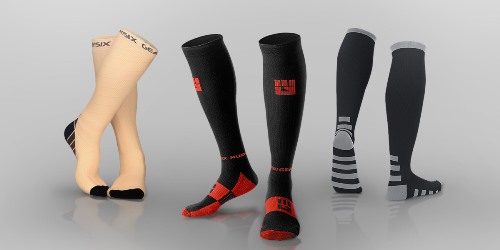
Nevertheless, because different people have feet and legs that are shaped differently and have different levels of circulation, it is wise to look for compression socks that will apply pressure at the correct level to the affected leg.
Also, the level of compression varies. If, for example, a brand highlights the grade of compression, there is a very high tendency that you will be getting real compression instead of something that will later turn out to be tighter than you need. Sadly, many brands do not provide this information and it makes it harder to get the right compression socks for your needs.
You will find a wide range of different fabrics used in the construction of compression socks as well. Some add compression with layering to ensure that the feet are kept warm. Others use moisture-wicking technology to reduce moisture and add comfort to the user. You must think about these factors and consider when and where you are likely to use such features.
Think about the thickness of the sock and how it will likely feel in your walking or running shoes. No compression sock can help you if you have got blisters because your shoe, so the sock thickness you opt for should leave some wiggle room for your toes.
Buying Guide for Compression Socks
Key Considerations
Sixty thousand miles of blood vessels run throughout the body. To put this number in perspective, the entire United States is just 2,802 miles across. You can create a mental picture now. Your blood vessels are instrumental in the distribution of oxygen and nutrients throughout the body. They also help carry waste from your organs and muscles.
When the blood vessels in your feet stop functioning correctly, this can result in problems and complications of all sorts. You may begin to feel cold or numb, and in some cases, your feet may start to wobble. Injuries to your legs and feet will also take longer than usual to heal. Other problems may arise, from body hair loss to dry skin and even erectile dysfunction in severe cases.
Diabetes and obesity are two factors that can cause issues in blood flow. Peripheral artery disease is a condition that occurs when there is an accumulation of plaque in the blood vessels. If ignored or left untreated, it can result in health problems such as leg edema and varicose veins. Raynaud’s Disease, a rare condition, can lead to difficulties in circulation in the lower body. According to the Mayo Clinic, the cause of Raynaud’s Disease is unknown. All we know is that it mostly affects middle-aged women living in cold climates.
One of the most effective ways to improve blood circulation in your feet and lower body is by wearing compression socks.
Compression socks squeeze the tissues of the legs and venous walls. It forces blood in the legs into narrow channels. This increase in the pressure in the arteries of the lower body makes it easier for blood to flow back to the heart.
There are many health benefits associated with using compression socks. Professionals such as athletes use them to improve performance and to avoid injuries. People who have varicose veins make use of compression socks to ease their pain and to prevent further progression of their condition. Pregnant women use them as well, as do those whose jobs require standing for long hours. People who are just recovering from surgery also use them.
Make sure to consult with your doctor before using compression socks, especially if you have a history of serious medical issues. People suffering from septic phlebitis, heart failure, ischemia, and related diseases are advised not to wear them.
1. Compression Level
Compression pressure is measured in millimeters of mercury, or mmHg. Compression alone is not a guarantee of more health benefits or better quality. Based on this, you do not need excessive compression if all you need is pressure to prevent the development of varicose veins or relieve mild pain. It’s always a good idea to seek advice from your doctor first before buying a pair of compression socks if you’re not sure on the compression level you need.
2. Reason for Use
Some compression socks can be used for sports as they have specific features, such as ergonomic designs and extra padding around the arch and ankle areas, as well as bright colors, that make them ideally suited to sports uses. Others are designed to suit the needs of people who have specific medical conditions. Compression socks that are classified as medical-grade tend to offer more compression and support as compared to those used for athletics or casual purposes.
3. Coverage
In general, the more surface area covered by a compression sock, the more difficult it is to put on and remove. Compression socks with full coverage are an ideal option for specific medical conditions. Full-length, open-toe stockings strike a good compromise between ease of use and surface area.
4. Comfort
To be realistic, if your compression socks aren’t comfortable, you probably won’t wear them. When buying compression socks, choose one made with a material you feel comfortable in. If you’re not satisfied with the way your compression socks feel when you wear them, return them and ask for a refund, or better still, exchange them for a better pair.
5. Style
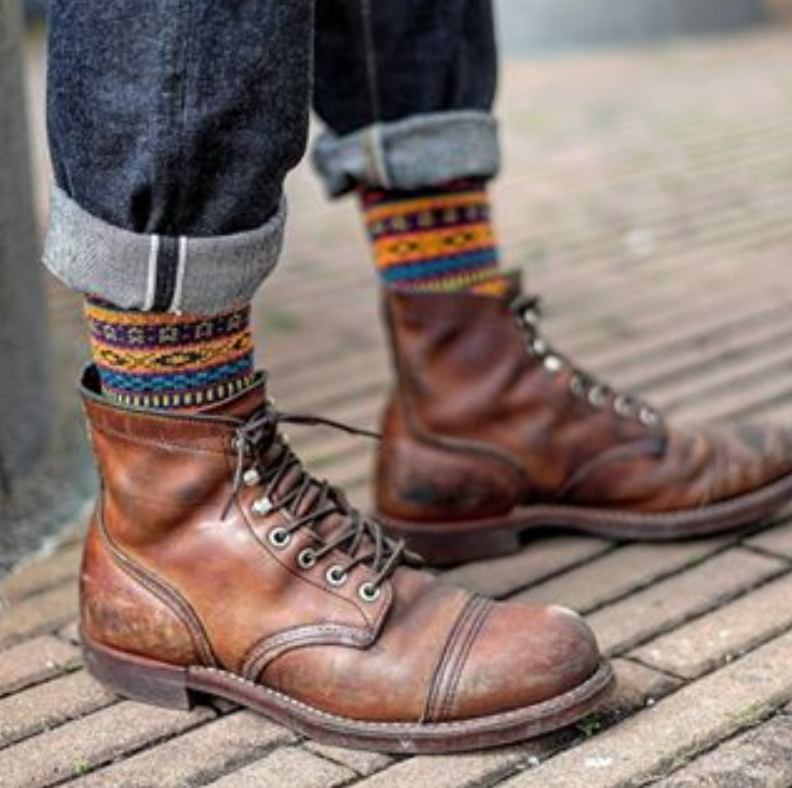
If you intend to use your compression socks regularly, make sure to buy a pair that blends perfectly with other items in your wardrobe. Compression socks are available in different patterns and colors. Nowadays, compression socks do not have to look like medical equipment. Innovation has brought about many stylish designs and features when it comes to compression sock choices, and they are now available in all kinds of different colors and designs.
6. Material
The most popular materials used in making compression socks are microfiber, cotton, and spandex. Most athletic compression socks are manufactured from merino wool, which is obtained from merino sheep. The fibers of merino wool are very delicate, soft, and less itchy as compared to ordinary wool.
7. Convenience Features
Compression socks often have convenience features built into them such as side zippers. These make it easier to put the socks on and remove them. If you intend to wear your compression socks under your clothes, you should choose a pair with a zipper. If you have trouble putting on or removing your compression socks, you may need to get a donning tool.
8. Pressure Rating
Compression socks come in a wide range of rated pressure degrees and tightness which stipulate the amount of pressure the socks will place on your legs.
- Light pressure socks range under 15 mmHg and are suitable for healthy people who can stand all day.
- Mild compression in the 15-20 mmHg range is the most effective and is the first grade to be used in preventing deep vein thrombosis in airline passengers.
- Moderate compression above 20 mmHg is medical-grade compression effective for edema, varicose veins, and preventing blood clotting after surgery.
- Firm compression in the 30-40 mmHg range is used for post-surgery, chronic illness, or when prescribed by a doctor.
Price Ranges
Budget
If you want to buy compression socks, the cheapest and most budget-friendly are low-cut/casual wear socks. You can get them between $10 and $15. Full-length casual compression socks are a bit costlier.
Mid-Range
The next you can get are athletic compression socks. A high-quality product in this range will cost about $25. Athletic compression socks with brand names are a bit more expensive.
High-End
In general, full-length, medical-grade compression socks are the most expensive compression socks on the market and they cost $30 or so.
Frequently Asked Questions (FAQs)
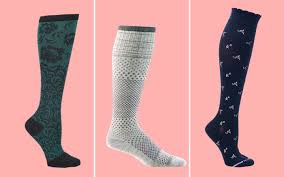
Q: How can I differentiate between uniform and graduated compression socks?
A: Graduated compression socks, often referred to as graded or gradient compression socks, are designed specifically to place pressure around your foot and ankle area. The farther up the leg they go, the less pressure they apply. Uniform compression socks, on the other hand, distribute compression in an even manner. Aside from being very easy to wear as compared to uniform socks, graduated socks are certified to be most effective. This is why some medical-grade compression socks are graduated.
Q: How much compression do I need?
A: Compression ratings differ. Compression socks with 8-15 mmHg are classified as mild and are useful for relieving foot, ankle, and leg pain while reducing swelling. Medium compression socks (15-20 mmHg) help stop the development of varicose veins, while firm compression socks (20-30 mmHg) help in the management of ulcers and in the prevention of complications such as blood clotting after surgery. Extra firm compression socks with 30-40 mmHg compression are used in the treatment of chronic edema and lymphedema. Socks rated RX grade with a compression of 40-50 mmHg are used for treating chronic venous insufficiency and severe conditions related to vein dysfunction.
Q: Are compression socks useful for boosting sports performance?
A: In a recent study published by the US National Library of Medicine, it was found that compression socks do not help marathon runners run faster or longer. Nonetheless, the same study indicated that compression socks can help prevent inflammation and reduce pain around the muscles in the legs, so they are still very helpful to use.
Tips and Tricks to Getting the Relief You Need
- Check with your doctor first.
The first mistake people make when purchasing knee-high compression socks is self-diagnosing themselves. To get the right support that you need, it is best to check with a trained medical professional. Your doctor will take every detail into consideration before recommending the best medical grade knee-high compression sock for you. Sometimes, when people overlook this and choose a size or compression level that is unfit for them, it can be harmful to them.
- Use talcum powder.
This is one trick that many people have not realized yet. We’re glad to be revealing this life hack or should we say, “sock hack”!
If you’re conversant with using knee-high compression socks, you know that it can be difficult to take them off, especially after wearing them for a very long time. If you experience trouble putting on or removing your knee-high compression sock, talcum powder is your answer. Apply the powder on your skin before wearing your socks and putting them on and taking them off will be much, much easier.
- Don’t put them on if your legs are already swollen.
A cautionary tip, especially when it comes to wearing compression stockings, is to avoid putting them on when your legs are already swollen. If you have been walking without them for a long period of time, elevate your legs for a while so that the swelling subsides, then put them on. Putting compression socks on swollen feet can cause more harm than good.
- Wearing knee-high compression socks at night has no real benefit.
One misconception when it comes to knee-high compression socks is that they work best at night. While lying down, your blood flow is at its best and so it is unnecessary to put compression socks on while sleeping. The best time to put your compression socks on is in the morning.
- Wear them correctly for the best results.
Some people come to the conclusion that their compression socks are not working when, in fact, they had been putting them on incorrectly the entire time. If your compression socks are not worn correctly, they will not work correctly. When you feel that your socks do not fit well, take the time to readjust them. This should be done during the day for the best results.
Conclusion
Taking all of the above into account, compression socks are more of an asset than a liability. If you have any of the conditions highlighted above such as deep vein thrombosis, do not hesitate to consult with your physician about the potential benefits of compression socks. As noted, some health cases preclude the use of compression socks, so if you suffer any of these conditions, speak with your doctor first before embarking on a compression sock health treatment.
Furthermore, only speak with specialist doctors since their wide range of knowledge on compression socks will help you address your issues more precisely. These doctors will also give you advice that is accurate.
Always keep in mind your budget and your physical requirements before wearing compression socks either in the knee-high length or the thigh-high length. Even if you do not have health complications but have the desire to use an alternative to other methods of physical care and rehabilitation and want to try compression socks out, first consult your doctor before moving from one treatment to the other.
Compression socks can really help you live a more comfortable and illness-free life, at least when it comes to issues of foot and leg circulation and related illnesses.
Contrary to what you may have heard about them, compression socks are indeed a great way to enjoy physical comfort at low cost and are the preferred treatment of many over more invasive or unnatural alternatives.
